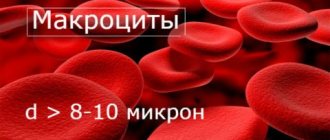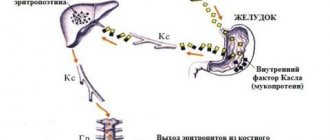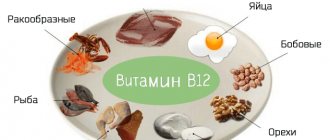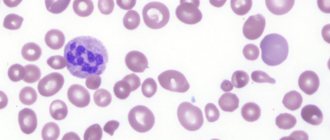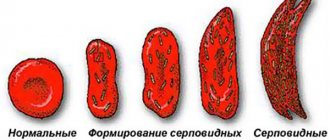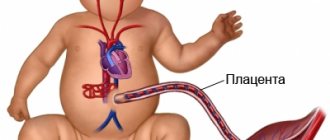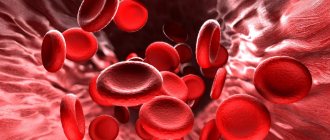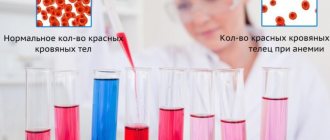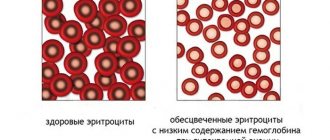Anemia leads to abnormal blood patterns due to damage to red blood cells. The posthemorrhagic form of the disease can have a chronic or acute course. Treatment of pathology is carried out by a doctor, taking into account the characteristics of a particular patient. The condition is considered life-threatening, as it affects all systems and organs of the body.
ICD-10 code
Chronic posthemorrhagic anemia has the following ICD-10 code - D50.0, and acute - D62. These disorders are located in the section “Anemia associated with nutrition. Iron-deficiency anemia".
Latin defines the word anemia as “lack of blood,” literally speaking. The word can also be translated as “anemia,” which means a lack of hemoglobin. And “hemorrhagic” is translated as “accompanied by bleeding,” the prefix “post” means “after.”
Information about what posthemorrhagic anemia is will allow you to detect its development in time and provide the necessary assistance.
Disease prevention
During the period of recovery of the body after an illness, patients need to increase the immune barrier. This is due to susceptibility to infection by various pathogenic microorganisms. In this situation, immunostimulants based on extracts of aloe, ginseng, lemongrass, and echinacea are used.
Tea with the addition of lemongrass will help restore the body's defenses
Prevention of the development of posthemorrhagic anemia involves, first of all, maintaining a healthy lifestyle, observing safety rules in any field of activity and at home, and timely treatment of all current diseases.
Don't forget about proper nutrition. Products should be rich in micro- and macroelements and vitamins.
In cases of injury of any type, it is imperative to contact a medical facility for timely diagnosis.
Pathogenesis in posthemorrhagic anemia
Pathogenesis is a certain sequence of development of pathological changes, which makes it possible to judge the characteristics of the occurrence of posthemorrhagic anemia.
The severity of posthemorrhagic anemia is determined by the hemoglobin content and the severity of tissue hypoxia due to its deficiency, but the symptoms of anemia and its features are associated not only with this indicator, but also with others that decrease with blood loss:
- Iron content
- Kalia,
- Magnesium,
- Copper.
Iron deficiency has a particularly negative effect on the circulatory system, in which the production of new blood elements is difficult.
The minimum volume of blood that can be lost without the risk of developing serious disorders is 500 ml.
Donors donate blood without exceeding this amount. A healthy human body with sufficient body weight completely restores lost elements over time.
When there is not enough blood, small vessels constrict to compensate for the shortage and maintain blood pressure at a normal level.
Due to a lack of venous blood, the heart muscle begins to work more actively to maintain sufficient minute blood flow - the amount of blood that is ejected by the heart per minute.
The functioning of the heart muscle is impaired due to mineral deficiency, the heart rate decreases, and the pulse weakens.
Anemia
An arteriovenous shunt (fistula) occurs between the veins and arterioles, and blood flows through the anastomoses without touching the capillaries, which leads to impaired blood circulation in the skin, muscular system, and tissues.
Formation of an arteriovenous shunt, due to which blood does not flow to the capillaries
This system exists to maintain blood flow to the brain and heart, allowing them to continue to function even in the face of severe blood loss.
Interstitial fluid quickly compensates for the lack of plasma (the liquid part of the blood), but microcirculation disturbances persist. If blood pressure drops significantly, the speed of blood flow in small vessels will decrease, leading to thrombosis.
In the severe stage of posthemorrhagic anemia, small blood clots form that clog small vessels, which leads to disruption of the functioning of the arterial glomeruli in the kidney tissue: they do not filter fluid properly, and the amount of urine excreted is reduced, and harmful substances are retained in the body.
Blood circulation in the liver also weakens. If acute posthemorrhagic anemia is not treated promptly, it will lead to liver failure.
With posthemorrhagic anemia, the liver suffers due to lack of blood
Oxygen deficiency in tissues leads to the accumulation of under-oxidized elements that poison the brain.
Acidosis develops: a violation of the acid-base balance towards the predominance of an acidic environment. If posthemorrhagic anemia is severe, the amount of alkalis is reduced, and the symptoms of acidosis increase.
With blood loss, the level of platelets decreases, but this has little effect on the coagulation processes: the content of other substances that affect coagulation reflexively increases.
Over time, the clotting mechanisms return to normal, but there is a risk of developing thrombohemorrhagic syndrome.
Prognosis and complications
The prognosis for posthemorrhagic anemia depends on the duration and intensity of bleeding. With timely initiation of treatment, it is favorable, and it is usually possible to completely restore normal values. Against the background of anemia, the nutrition of organs deteriorates, which affects their functional state. If a large volume is lost (up to ½ of the total bcc), there is a possibility of death due to a critical decrease in blood pressure and the development of multiple organ failure.
Posthemorrhagic anemia requires timely treatment, since a decrease in hemoglobin levels and the number of red blood cells affects the functional state of all organs and systems.
Bibliography
- W. Rosset, F. Bonn. Hemolytic and acute posthemorrhagic anemia. From Harrison's Principles of Internal Medicine. 14th edition.
- Kassirsky I.A., Alekseev G.A. Clinical hematology. M.: Medicine. 1973. 800 p.
- Vorobiev A.I. Pathogenesis of acute blood loss//Problem. hematol. and transfusiol. 1999. No. 2. P. 5-6.
- Abdulkadyrov KM Hemocomponent therapy for blood diseases // Klin. medical 1994. No. 2. P. 10-13.
Causes
The main factor influencing the development of posthemorrhagic anemia is blood loss, the causes of which can be different.
Acute posthemorrhagic anemia
This is a disorder that develops rapidly due to excessive blood loss. This is a dangerous condition that requires rapid initiation of treatment measures.
Causes of acute anemia:
- Mechanical damage to blood vessels. Occur due to various injuries and errors during surgical interventions.
- Rupture of an aneurysm on the wall of a large vessel , which includes the aorta, peripheral vessels, and pulmonary arteries.
- Complications of ectopic pregnancy. If a pathological pregnancy is discovered late, the walls in the area where the fetus develops break through and intense bleeding begins.
- Rupture of the spleen due to trauma.
- Intense bleeding in the uterus during pathological pregnancies or due to menstrual irregularities. In the second case, chronic anemia often develops.
- Ulcerative diseases. An ulcer of the duodenum or stomach is aggravated by profuse bleeding. With hidden bleeding, a chronic type of anemia is observed.
- Severe coagulation disorders. Low levels of elements that control the clotting process and excessive intake of anticoagulants lead to acute bleeding in the digestive tract.
Chronic posthemorrhagic anemia
A condition that develops with systematic blood loss over a long period of time. It can go unnoticed for a long time if the blood loss is mild.
Causes of chronic anemia:
- Moderate bleeding disorders. Mild to moderate disruptions in the coagulation processes lead to periodic minor bleeding (nasal, renal, gastrointestinal tract). Also, hemorrhage (bleeding) occurs under the influence of other factors: ulcers, inflammatory processes.
- Hemophilia. This is an inherited bleeding disorder that increases the risk of bleeding from even minor injuries. It can provoke both acute and chronic posthemorrhagic anemia.
- Thrombohemorrhagic syndrome. With this pathology, disturbances in coagulation processes are observed. The disease develops against the background of severe traumatic injuries, shock conditions, and septic lesions.
- Malignant neoplasms of the stomach or intestines. If the tumor affects organs and tissues, this leads to bleeding of varying intensity.
- Leukemia. With leukemia, all hematopoietic processes are disrupted.
- Sepsis. With septic lesions, posthemorrhagic anemia develops due to the consequences of hemolysis, intoxication, and metabolic disorders.
- Haemorrhoids. Hemorrhoidal anemia develops due to systematic bleeding in this disease; it can be acute or chronic, depending on the severity of the pathology.
- Helminthiasis. The intestinal parasite disrupts the integrity of the walls, which leads to systematic bleeding. In adults, this disease is rarely detected.
Hemorrhagic anemia also develops due to vitamin C deficiency.
Diagnosis of anemia, including blood tests
Anemia is diagnosed only after bleeding has stopped. At the same time, in parallel, in any possible way, the volume of lost blood is replenished (if necessary).
Initially, for maximum effect, in order to bring the patient out of shock and increase blood pressure to normal, doctors transfuse at least 500 ml of plasma substitute. The initial administration of Polyglyukin is carried out in a stream, and when the systolic pressure reaches 100, the injection is replaced with a drip. Sometimes the dose of the administered solution can reach two liters.
Only after all the necessary manipulations do doctors begin diagnosing the patient’s anemic condition.
To make a diagnosis, a number of tests are necessary, including blood biochemistry
Of course, an obligatory stage of diagnosis is collecting anamnesis and identifying possible causes underlying the disease. The diagnosis itself is made on the basis of a combination of studies: clinical and laboratory.
Basic methods
The diagnosis of posthemorrhagic anemia is based on basic studies:
- general and biochemical blood test;
- Analysis of urine.
If the presence of posthemorrhagic anemia is detected, laboratory blood tests will show:
- decreased hemoglobin content with a slight decrease in red blood cells;
- decrease in the level of saturation of red blood cells with hemoglobin;
- decreased serum iron levels;
- increased erythrocyte sedimentation rate;
- decreased platelet count.
Kinds
Posthemorrhagic anemia is divided not only by the nature of its course (acute or chronic), but also by other criteria.
The severity of anemia is assessed by the amount of hemoglobin in the blood.
Depending on its content, anemia is divided into:
- Light. With mild anemia, hemoglobin begins to lack iron, its production is impaired, but the symptoms of anemia are practically absent. Hemoglobin does not fall below 90 g/l.
- Average. Symptoms with moderate severity are moderate, hemoglobin concentration is 70-90 g/l.
- Heavy. In severe cases, serious organ dysfunction is observed, heart failure develops, and the structure of hair, teeth, and nails changes. Hemoglobin content is 50-70 g/l.
- Extremely severe. If the hemoglobin level is below 50 g/l, there is a risk of life.
There are also certain pathologies included in the ICD:
- Congenital anemia in the newborn and fetus due to blood loss (code P61.3),
- Posthemorrhagic anemia of the chronic type, which is secondary iron deficiency (code D50.0).
Symptoms
Acute form of anemia
Symptoms in the acute form of posthemorrhagic anemia increase very quickly and depend on the severity of blood loss.
Observed:
- Pallor of the skin,
- Cyanotic lips
- Marked weakness
- Increased sweating
- Dizziness,
- Nausea, vomiting is also possible,
- The surface of the tongue is devoid of moisture,
- Rapid heartbeat, extrasystolic activity may occur,
- Weak, difficult to palpate pulse,
- When listening, there is a noticeable muffling of heart sounds,
- Reduced blood pressure,
- Breathing is weak, there is shortness of breath,
- Body temperature does not exceed 36 degrees.
A decrease in blood pressure due to massive blood loss is called hemorrhagic shock. The intensity of the fall in blood pressure depends on the severity of blood loss.
The following symptoms are also present:
- Tachycardia,
- The skin is cold and pale, in moderate and severe cases it has a cyanotic (bluish) coloration,
- Impaired consciousness (stupor, coma, loss of consciousness),
- Weak pulse (if the stage is severe, it can only be felt on the main vessels),
- Reducing the amount of urine excreted.
Posthemorrhagic anemia
The symptoms of posthemorrhagic anemia and hemorrhagic shock are accompanied by signs that are inherent to the disease that caused blood loss:
- With an ulcer, black or red stool is observed,
- Swelling in the impact area (if injured),
- When the arteries in the lungs rupture, there is a cough with bright scarlet blood,
- Intense bloody discharge from the genitals during uterine bleeding.
The source of bleeding is identified by indirect signs depending on the clinical picture.
Symptoms of the disease
There is a general set of symptoms that occurs with the development of anemia (anemic syndrome):
- fast fatiguability;
- drowsiness;
- noise in the ears and head;
- dyspnea;
- pallor of the integument.
Dry mouth is one of the signs of anemia
If acute anemia progresses, the following symptoms are additionally observed:
- dizziness;
- headache;
- fainting;
- thirst;
- nausea;
- brittle nails;
- profuse sweating;
- dry mouth;
- shallow breathing;
- cardiopalmus;
- decreased body temperature;
- decrease in blood pressure.
Different types of internal bleeding can manifest themselves in different ways.
Uterine bleeding is often accompanied by dizziness and headaches
The patient may detect the following manifestations of the disease:
- loose, bloody stools, which may be evidence of a stomach ulcer;
- cough accompanied by bright red sputum, which is characteristic of bleeding in the lungs;
- increasing swelling at the site of a bruise or fracture, confirming intramuscular or subcutaneous bleeding;
- bloody discharge from the vagina.
If a combination of several symptoms characteristic of anemia occurs, you need to urgently consult a doctor to make a correct diagnosis and prescribe the necessary treatment.
What is the reason for the appearance of bloody discharge between periods: https://krasnayakrov.ru/organizm-cheloveka/zhenshina/krov-meghdu-mesyachnymi.html
Stages of acute posthemorrhagic syndrome
Acute posthemorrhagic syndrome has three stages of development.
| Name | Description |
| Reflex-vascular stage | The level of plasma and red blood cells drops, compensatory processes are activated, blood pressure drops, and the heart rate increases. |
| Hydremia stage | It develops several hours after blood loss and lasts from 2 to 3 days. Intercellular fluid restores the volume of fluid in the vessels. The content of red blood cells and hemoglobin decreases. |
| Bone marrow stage | Develops 4-5 days after blood loss due to oxygen starvation. The level of hematopoietin and reticulocytes, the precursor cells of red blood cells, increases in the blood. The amount of iron in the plasma decreases. |
The body fully recovers after blood loss after two to three or more months.
Nutrition for anemia
If you have anemia, you need to eat right
An addition to the treatment of posthemorrhagic anemia is a special diet. The patient's diet should consist of foods high in iron:
- fresh and boiled vegetables;
- lean varieties of beef and pork;
- rabbit meat;
- veal;
- liver;
- cottage cheese;
- egg white;
- greenery;
- sea fish.
Replenishment of fluid in the body is required, so doctors recommend drinking at least 2 liters of water daily. In addition, natural juices will be very useful:
- plum;
- cranberry;
- pomegranate;
- currant;
- grapefruit;
- apple.
Signs of chronic form
Chronic bleeding gradually leads to posthemorrhagic anemia, which develops gradually, and its symptoms are closely related to the severity of hemoglobin deficiency.
Observed:
- Pale and dry skin,
- Swelling of the face,
- Impaired perception of taste and smell, changes in taste preferences,
- Weakness and increased hair loss,
- Fragility and smoothness of the nail plates,
- Excessive sweating
- Nausea,
- Rapid heartbeat
- Dizziness,
- Feeling of weakness, severe fatigue,
- Low-grade body temperature (37-37.5),
- Headache.
People with posthemorrhagic anemia have low immunity and often develop infectious diseases.
Diagnostics
In case of acute blood loss, the patient remains in hospital treatment so that risks can be assessed and timely assistance provided.
Laboratory diagnosis of posthemorrhagic anemia is carried out repeatedly, and the results vary depending on the stage and severity of the disorder.
Laboratory signs of acute anemia:
- In the first two hours, the concentration of platelets increases, and red blood cells and hemoglobin remain at normal levels,
- After 2-4 hours, the excess platelets remain, neutrophilic granulocytes grow in the blood, the concentration of red blood cells and hemoglobin decreases, according to the color indicator, anemia is defined as normochromic (normal value),
- After 5 days, an increase in reticulocytes is noted, the iron level is insufficient.
What tests need to be taken?
It is necessary to take a general blood test; in case of chronic anemia, it reveals the content of elliptocytes; lymphocytes are increased in the peripheral blood, but reduced in the overall cellular composition.
A deficiency of iron, calcium, and copper is detected. Increased manganese content.
In parallel, tests are carried out to determine the cause of bleeding: stool examination for helminthiasis and occult blood, colonoscopy, urinalysis, bone marrow examination, ultrasound examination, esophagogastroduodenoscopy, electrocardiogram.
Who to contact?
Hematologist
Hypochromic anemia
With this form of the disease, there is too little hemoglobin in the red blood cells. To identify pathology, the hemoglobin level is examined. The value of the color index is also studied. It determines how much hemoglobin one red blood cell contains. Normally, this figure is 0.80-1.05. This is a calculated value, so it is not expressed in any specific manifestations.
In addition to determining the indicators described above, pathology is determined by the size and shape of red blood cells. If a person has hypochromic anemia, they become like a ring with a dark rim. Also during the analysis, clearing is noticeable in the center of the red blood cell.
Chronic hypochromic anemia is divided into several types:
- iron deficiency;
- iron-saturated;
- iron redistribution;
- anemia of mixed origin.
Chronic iron deficiency anemia affects about 10% of all women 18-45 years old. Blood loss is another main cause of hypochromic anemia.
All patients over 40 years of age who are iron deficient are screened for colon cancer. Sometimes this symptom is associated with taking Prednisolone and Aspirin.
Hypochromic anemia often develops in pregnant women. This is explained by the fact that the development of the fetus and placenta requires a lot of iron. If you do not consume it in sufficient quantities for mother and baby, there will be a deficiency of the vital mineral. This type of anemia also occurs in adolescents when the body requires increased doses of vitamins and minerals.
Symptoms of hypochromic chronic anemia:
- increased fatigue;
- frequent dizziness;
- brittle nails and dry skin;
- decreased appetite.
With this pathology, the patient’s taste changes dramatically; often there is a desire to try chalk, toothpaste, or raw cereal.
Treatment
Acute hemorrhagic anemia at the first stage of treatment requires eliminating the cause of blood loss and restoring normal blood volume.
Surgeries are performed to suture wounds and blood vessels, and the following medications are prescribed:
- Artificial blood substitutes. They are infused by drop or stream, depending on the patient’s condition,
- When shock develops, the use of steroids (Prednisolone) is indicated.
- Soda solution eliminates acidosis,
- Anticoagulants are used to eliminate blood clots in small vessels.
- If blood loss exceeds a liter, a donor blood transfusion is necessary.
Treatment of chronic anemia not complicated by serious diseases is carried out on an outpatient basis. Nutrition correction with the addition of foods containing iron, vitamins B9, B12 and C is indicated.
In parallel, treatment is carried out for the underlying disease that caused the pathological changes.
Treatment with drugs and folk remedies
For posthemorrhagic anemia, the main goals of treatment are to identify the source of blood loss and stop the bleeding. For external injuries, apply a tourniquet and bandage. If necessary, vessels and damaged tissues and organs are sutured and resection is performed.
In case of massive blood loss, measures are carried out in the hospital:
- To restore blood supply and hemodynamics, a transfusion of canned blood and plasma is performed. When hemoglobin is below 8%, plasma substitutes are used: “Hemodez”, “Polyglyukin” or “Reopoliglyukin”. The blood transfusion procedure is carried out promptly, since a quarter of the blood loss is fraught with the death of the patient. The volume of infused fluid in this case exceeds blood loss by a maximum of 30%.
- Transfusion of red blood cells is necessary to restore oxygen transport; with rapid loss, its amount can be half a liter.
- Shock is treated with Prednisolone.
- To restore the acid-base balance during treatment, electrolyte and protein compounds are administered intravenously: albumin, glucose, saline.
- Iron is replenished by such drugs as Ferroplex, Feramide, Conferon, Sorbifer Durules. They are taken orally or by injection.
- Microelements are prescribed: cobalt, copper and manganese, as they increase the absorption of iron.
For prolonged bleeding:
- In the case of severe chronic anemia, transfusion is carried out in a small volume.
- To eliminate the symptoms of functional disorders in the heart, liver, and kidneys, therapeutic measures are used.
- For better absorption of Fe, iron-containing products, vitamins C and B groups are prescribed.
- Sometimes surgery is recommended.
The regimen and duration of drug treatment are individual in each specific case. Restoration of the normal picture is observed after one and a half or two months, but the patient takes the medicine for up to six months.
Forecast
If, after extensive blood loss, the patient quickly arrived at the hospital and received the full range of treatment procedures aimed at restoring blood levels and eliminating bleeding, then the prognosis is favorable, except in cases where the blood loss is extremely severe.
A chronic type of pathology is successfully eliminated by curing the disease that caused it. The prognosis depends on the severity of concomitant diseases and the degree of neglect of anemia. The sooner the cause is identified and treatment is started, the greater the chances of a favorable outcome.
